- Bastiaan “Bart” M. Drees, Dec. 27, 2016
Expectations. There were expectations for the children in the Jan and Jacky Meijer Drees family: Each had to take at least 5 years of lessons to learn to play a musical instrument. In second grade at the age of seven, I started taking piano lessons. My older brother and sister did the same. However, when our uncle and aunt, Joop and Kia Vaandrager, arrived in Dallas, Texas from the Netherlands in 1960, along with their antique ¾ size cello. I was selected to switch from piano to cello lessons. For the next 5 years I was instructed by Mrs. Herscowitz who played cello with the Dallas Symphony Orchestra.
Rules. There were also rules in the Drees household: No guns or bullets. My parents, having gone through World War II, knew well the horrors guns produce. Not even play guns were permitted. So, my brother, sister and I quickly learned that we had to borrow toy guns when we played cowboys and Indians in the new neighborhood on Stichter Avenue. Walter and Sammy Morgan had weapons! We played there a lot. I usually played the part of the Indians. One time I brought home one of the toy bullets from Walt and Sam’s house, and my Mom discovered it in my pocket. I was in big trouble and assured them I would never, ever do that again.
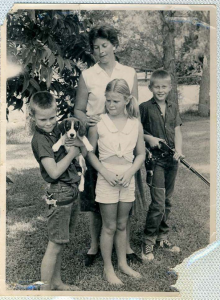
Music in the family. The cello is not an easy instrument to play, and my parents endured the screeching and scratching of out-of-tune notes dutifully, as I tried practicing half an hour every day using a wind-up timer and learning how to read music in the bass clef. They bought my siblings a brand new, upright piano and introduced them to Mrs. Gaynor, their piano teacher for the next 5 years. My Dad was in the habit of making audio recordings on his reel-to-reel tape recorder and we have family recordings of each of us playing pieces of music which were sent to my grandparents (Oma and Opa) in Holland.
My grandmother, Frouk (“Frieda”) Vaangrager, is said to have been an accomplished pianist with perfect pitch. None of her kids grew up to be particularly musical. Perhaps they were intimidated by their mom’s talent level and felt like they could not even compete. That is why playing music passionately seems to be a generation skipping kind of thing. Anyway, my mom did know how to read music and spent a considerable amount of time with me on the cello.
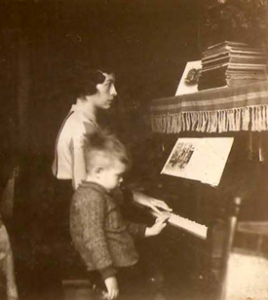
Time to shine. I played in the orchestra beginning in Preston Hollow Elementary School (grades 1-6), through Benjamin Franklin Junior High School (grades 7-8), and through my sophomore year in Hillcrest High School (grades 9-12). I had my short moments of fame: In grade school, our orchestra had the opportunity to play on a television show. I remember getting all dolled up for the concert. Excited and ready to go, I put my cello in the back seat of our family’s station wagon, a blue 1959 Chevrolet Impala that my parents bought with cash upon emigrating from Holland (they had not been aware of the idea that in America anyone could buy anything big like a car using credit from a loan).
Frieda breaks my neck. Anyway, it was getting time to leave. My sister, Frieda, was ready to go and hopped into the back seat of the station wagon – right on top of my cello, breaking the neck! To avoid panic (or placing blame), my aeronautical engineer and helicopter pioneer dad quickly set about fixing the damaged instrument using epoxy glue (adding the two-part mixture together and smearing it onto the broken surfaces) and a couple of nails. Epoxy takes hours to set, in contrast to more modern super glue. Amazingly, the neck held up to a tuning check, and we made it to the studio in time. I played the piece of music with my thumbs sliding up and down the cello neck through the still wet sticky and stinky glue.
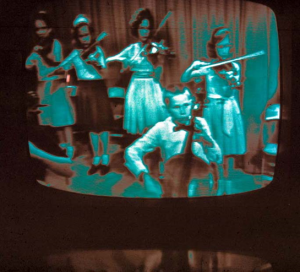
In junior high and high school, I played in every musical and graduation ceremony, enjoying the music of “The King and I”, “South Pacific”, “Oklahoma”, and playing “Pomp and Circumstance” ad nauseum as graduating schoolmates crossed the stage during graduations. I truly enjoyed playing the music, particularly quartets in practice rooms. However, I gradually progressed from playing first chair cello to fourth chair over the course of my career as a cellist. Why? Well, the Beatles had taken over the music world, and their popular, long-haired image and artistic edginess ruled. Simply put, playing in the orchestra became “square.” I practiced less and less and HATED dressing up in formal clothes and playing on the stage in front of all my “cool” friends.
A similar situation had occurred for me as a Boy Scout: I loved the camping and made it to being a Star scout with my dad getting into being Scout Master, …but when we had to wear our uniform to school in junior high school, it was not cool. In both cases, getting out of doing what I thought was not cool at the time led to major confrontations with my parents. I’m sure dad was really hurt about me leaving Boy Scouts, and this attitude led to me dropping out of the orchestra for my senior year!
“Are you experienced?” In high school, Jimi Hendrix came out with “Purple Haze” and other acid rock tunes. By that time, I chose to add my own cello instrumentation to whatever the orchestra happened to be playing in class – adding Hendrix-like feedback and sliding guitar riff notes as I played along to the written music pieces. By then, I had become interested in learning to play guitar and piano – by ear. Having no guitar, I picked up my brother’s Silvertone nylon string. It was strung for my right-handed brother (being his guitar). I was left-handed. So, slowly, I learned to play that right-handed guitar. I soon realized, however, that learning to play songs by ear was wholly different from reading music: I could play those songs by ear and not forget them, ever. Music played from a printed page is just that. It can only be played again if you read the music again (or memorize it, which takes a lot of work and is only done by students preparing for recitals).
My learning curve with the family piano was a whole different experience. As the Beatles music evolved from a simple rock band to including other styles and instrumentation (as on their album, “Revolver”), I was inspired to begin experimenting with other instruments. Jimi Hendrix albums were a huge inspiration as well. So, I began ad-libbing tunes – usually pounding on bass notes loudly; perhaps this was because of my background in cello or because the bass notes are on the left-handed side of the keyboard? I would take the panel off the bottom of the piano to expose the piano strings and pick them like a harp using a guitar pick. Far out, man. The only big problem was with my family. My brother and sister had abandoned playing the piano after their required 5-year musical “sentence”. My brother, however, had moved on to playing in rock and roll groups like the “Styks and Stonz” and became locally well-known for playing on the TV dance show, “Shindig” with Ron Chapman, and being the opening act for a “Mamas and Papas” concert in Dallas. I was not appreciated as a pianist and if my mom was home when I played, she would yell: “Baaaarrrrrtttt!!!!!!” to shut me up. So, I did most of my best work when I was all alone in the house.
And it got easier being alone. My brother and sister had gone off to college, so for the first time in my life, I was the only kid at home. My mom had gone back to college to get a degree and certification to be a physical therapist. She worked part time. My dad continued to be pretty much of a workaholic at Bell Helicopter Company; they were busy designing and building helicopters to transport troops and fight in the Viet Nam War.
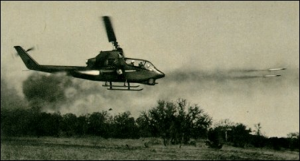
And I played louder. Playing “Hey Jude” and other rock songs on the piano loudly while I was at home alone resulted in a number of my earliest accomplishments: 1) I may have started the process of having hearing loss later in life (as in now); 2) I began to learn to play piano by ear with a lot of trial and error; and, 3) I broke a few piano strings, mainly the bass notes for C, F and G. Life goes on. So, these strings were laying around the house and found their way into the den where we had our television. “Dad’s chair” was covered with yellow carpet cloth and kind of boxy. He sat there when we watched the news on one of the three TV stations we could receive with our “V” shaped antenna. News often covered the Vietnam war, where the Bell Huey and Huey Cobra had become symbols of the U.S. effort there. (My brother and I were Beatles fans. We wore our hair as long as we could – to show our solidarity with John Lennon and his group in opposing the war. In fact, both my brother and I had low draft numbers, but did not get drafted because my Mom and Dad paid to put us through college where we had deferments. Keeping that status was essential to staying out of the war).
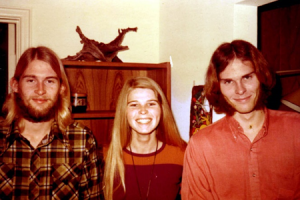
Dad spotted the broken piano strings and began playing with one them, shaking it to observe it making different kind of wave patterns. If you shake a string (about 3 ft. long) by its ends, it makes a single wave. By changing the timing of shaking the wires’ ends, you can make an S-shaped wave with a point in the middle that does not move much. That’s a node. On a guitar, that is like playing a harmonic note (e.g., putting your finger lightly on the octave E on the E string, making one node). When the wire shaking timing is adjusted more, the wire can be made to have three waves and two nodes, vibrating at a third of the length of the string. This is when Dad had a eureka moment!
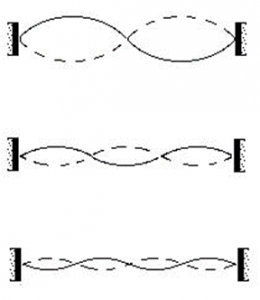
Music takes flight. My Dad is a pioneer in the history of the helicopter. In Holland, he and his friends designed and built the ram jet powered Kolibrie helicopter. He was hired by Bell Helicopter Corporation in Arlington, Texas, which also specialized in helicopters that flew on only two blades. The problem with two-bladed helicopters is that the motors shake. The fuselage, attached to that motor, also shakes. Shaking has serious repercussions in these models: nuts and bolts can get loose, metal fatigue and failure can occur, and it’s uncomfortable for passengers to endure for prolonged periods of time.
So, as my Dad explained to me, if there was a bar on which the vibrating motor is mounted in the middle, the fuselage could be hung from two nodes that occur at each end. The fuselage would not vibrate. Then he sternly told me not to tell a soul.
One of 15 patents. With Al Gallerstein, the lawyer at Bell Helicopters, my Dad had already filed for and obtained a number of patents (Dad had 15 patents over his career with the Bell Helicopter Corp.). He occasionally got royalty checks for his innovations. He told me that every time he got one, he would spend a little of it on something nice. That’s a practice I can agree with.
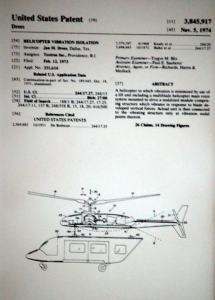
No Damn Magic. Some months later I learned that Bell Helicopter, under Dad’s supervision as Chief of Flight Technology and soon-to-be Vice President, had installed the new patent concept into its Jet Ranger production model and entitled the device the Noda-Magic. His friends and workmates called it “No Damn Magic”.
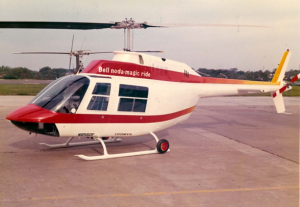
So much for no guns in the house. There was a lot of fanfare and marketing surrounding the introduction of this new helicopter, which now had a suspension system. In one of the marketing pieces I saw, the top billing was: “Finally, a stable shooting platform”. Dad was simply trying to make a more comfortable and durable helicopter. I wonder how Albert Einstein might have felt if he knew that his concept led to the destruction of two Japanese cities, ending World War II? Perhaps I should be taking the blame if ever those helicopters were used to shoot people in Vietnam or anywhere else. I was only trying to make music, which is real magic.
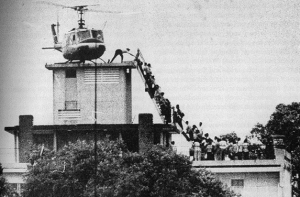
…………………………………………………………………………………………………………………………………..
Acknowledgments: I thank my lovely wife, Carol, and my 7-8th grade English teacher daughter, Erin Lien Snyder, for their editorial and constructive comments, most of which I have incorporated.